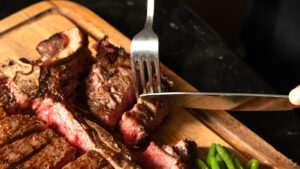Future of Food: A few tricks up a restaurateur’s sleeve

THOSE of us fortunate enough to have dined in one of Elbert Cuenca’s ventures (which include Elbert’s Steak Room, among all the other Elbert’s dotting the city) notice a certain vibe that places it a cut above the rest — without it, he wouldn’t have been in the food industry for almost 30 years now. Mr. Cuenca, from his talk at the Future of Food Conference in Center for Culinary Arts – Manila (CCA) on March 8, “Elevating the Guest Experience,” may credit his success to more than a few magic tricks up his sleeve.
For himself, he begins with a baseline (because as he said during the talk: how do you elevate something without a base?), as well as making benchmarks. He does this by educating himself by dining and figuring out how else he can improve based on his experience. “All I do is spend my money on restaurants, but that’s okay. That helps make me a better person, and a better restaurant owner. I will benchmark all the time.” Another tip he gave was to put himself into a customer’s shoes (which includes dining at his own places). “I need to know what our customers will be going through as well. For me to know what my customers need, I have to imagine myself as a customer.”
But the meat of his talk (pun intended) lay in the theater of dining.
“I like to think that restaurants are no different from cinemas and theaters. For the time that they [the customers] are with us, they are isolated from the outside world,” he said. He took it up a notch by saying that for the restaurant business, it’s an added challenge, because while movies and plays entertain with sight and so und (and the rest is padded by the imagination), restaurants deal with all five senses, and then some more.
He used entryways to illustrate sight: “What they see is the first thing that happens, right? You’re impressed. That’s why we spend money on design, on light, and furniture.” He then went into detail on other ways a restaurant can use visual cues to improve the experience: he started with his menu at Elbert’s Steak Room, for example: while a steak goes up to P16,000, his menu dispenses with the comma (to make the number feel smaller), and further perusing the menu yields details like the meal coming with soup, salad, a side dish, and coffee or tea. “As you browse my menu more, you are going to see a little more justification on price,” he said.
He showed a slide depicting the lighting scheme at one of his restaurants: “My lighting will only hit the center of the linen on the table.
“It makes all your ugly dates look beautiful,” he said, to a burst of laughter from the audience. “When the soft lighting hits… it enhances your customer experience.
“I will help your date look better. Whether it’s your wife, or blind date… you all feel good, because you all look good,” he added.
He even takes into account the sense of sound. “Is it too noisy? Too quiet? But this is part of the experience,” he said. “Tailor-fitted to each kind of restaurant I do, that’s the sound level I’ll make.” For example, in his fine dining ventures, the volume level “would always allow you to converse without having to raise your voice.” Bars are a different story, where louder music kicks up your spirits, while at his ramen ventures (including Mendokoro Ramenba, which he co-owns), the sound comes from the environment of bustle, the better to “commune” with your food.
As for smell, he advises restaurants to try to go neutral (though he cites cafes and fast-food restaurants as advertising their wares with smells: the scent of coffee in the first example, and the scent of fries in the latter). “If you enter a stinky restaurant, you’ve already lost your customer.”
The sense of touch (he cites oily cutlery as a turn-off) can also cooperate with the sense of sound — padding his tables underneath the linen gives a sense of security, softness, and luxury — and also helps muffle sound.
All these also rely on the reliability of staff: he said that there can be too much interaction between staff and diner (thus bothering the diner), so he cited his own recipe: “We will be there when you need us, we’re not beside your table at your beck and call; we are within sight of you.”
As he said: “I like to share it with my staff: our mission in life is to put smiles on people’s faces. Because we can, (and) because that’s what we’re supposed to do.”
He suggested not to make money the motivation: “Our motivation is the customer’s happiness. And when your customer is happy, they will validate that with the money that they give you.” — Joseph L. Garcia




